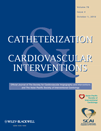Stenting of aortic coarctation: Acute, intermediate, and long-term results of a prospective multi-institutional registry—Congenital cardiovascular interventional study consortium (CCISC)†
Conflict of interest: CCISC received industry support from AGA, Siemens, Gore, Cook, Medtronic, NuMED, Atrium, BBraun, Cordis, and Arrow. Dr. Cheatham is a consultant and principal investigator for NuMED.
Abstract
Introduction: Since the 1980s, stent implantation has evolved as an important therapeutic strategy for coarctation of the aorta. However, available data is frequently flawed by short follow-up, lack of adequate follow-up imaging, and retrospective nature of data collection. Methods: Data was prospectively collected using a multicenter registry congenital cardiovascular interventional study consortium (CCISC). Between 2000 and 2009, 302 patients from 34 centers with a median weight of 58 kg underwent stent implantation for coarctation. Eligible patients (44%) completed intermediate follow-up (3–18 months) with integrated imaging (cath, CT, MRI), whereas 21% completed long-term follow-up (>18–60 months). Procedural success was defined as UL/LL systolic gradient of less than 20 mm Hg, lack of significant recurrent obstruction, and freedom from unplanned repeat intervention. Results: Acute procedural success was 96%. Cumulative intermediate success was 86%, and cumulative long-term success was 77%. Unplanned repeat interventions were required in 4%, and aortic wall complications were seen in 1% of patients (dissection n = 1 and aneurysm n = 3). Other adverse events (n = 15) occurred mainly acutely and included technical complications such as stent malposition (n = 9). At long-term follow-up, 23% of patients continued to have systolic blood pressure above the 95th centile, 9% had an upper-to-lower limb blood pressure gradient in excess of 20 mm Hg, and 32% were taking antihypertensive medication. Conclusions: This study documented acute, intermediate, and long-term outcome data comparable or superior with other surgical or interventional series. However, even with successful initial stent therapy, patients continue to require long-term follow-up and have associated long-term morbidity, relating to aortic wall complications, systemic hypertension, recurrent obstruction as well as need for repeat intervention. © 2010 Wiley-Liss, Inc.




